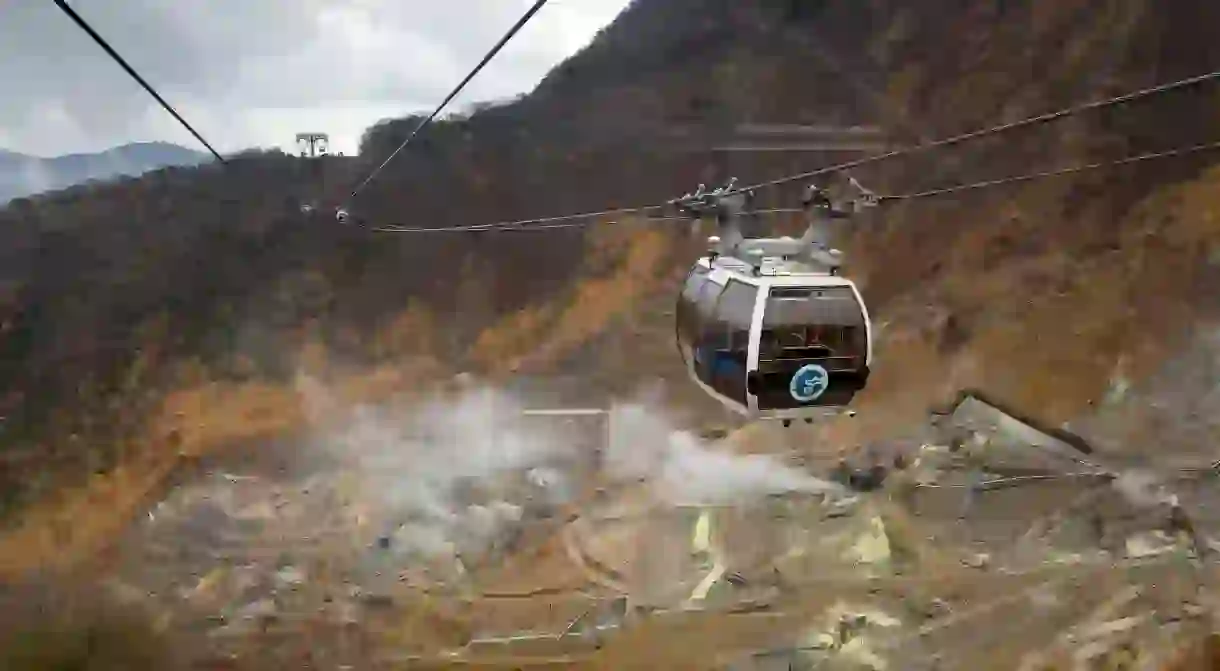A Complete Guide to Visiting Hakone From Tokyo

Hakone is a mountainous resort town just outside of Tokyo, popular with city dwellers and travellers looking to enjoy the region’s soothing hot springs, spectacular nature and eclectic art museums. Here, a practical guide to Tokyo’s favourite getaway, including getting there, what to do and more.
Please note: The Hakone Tozan Line between Hakone-Yumoto and Gora is currently closed until autumn 2020 due to a typhoon in the region. Replacement bus and rail services are available. For updates, check their website.
Getting to Hakone from Tokyo
Depending on your budget, there are a handful of ways to travel to Hakone from Tokyo. Japan Rail Pass holders can take the Tokaido Shinkansen or the Kodama Shinkansen from Tokyo Station to Odawara Station; both journeys take around an hour. Alternatively, the Shōnan-Shinjuku line from Shinjuku Station runs to Odawara, but takes around 80 minutes. From Odawara, the Hakone Tozan rail will take you to Hakone-Yumoto and Gora. JR Pass holders will have to buy a separate ticket for this portion of the journey.

A much quicker but slightly more costly way to get to Hakone from Tokyo is to take the Odakyū Railway from Shinjuku Station, which goes directly to Hakone-Yumoto. The limited express Romancecar, which is reserved seating only, zips passengers through scenic countryside from Shinjuku to Hakone-Yumoto in just 90 minutes. Alternatively, the regular express service takes two hours, and requires a transfer at Odawara.
Getting around Hakone
If you want to see all that Hakone has to offer, it’s highly recommended to purchase a Hakone Freepass. It can be purchased from Shinjuku Station as a round-trip pass, or from Odawara for those not returning to Tokyo. The two- or three-day passes cover you for all travel in the Hakone region, including the Hakone Tozan Railway, the Hakone Ropeway, the Hakone Tozan Cable Car and local buses. Discounts at museums and attractions in the region are also included.

What to do in Hakone
Hakone serves up a unique concoction of art, nature and hot springs, and experiencing all three is a must when visiting the region. Art museums include the Hakone Open-Air Museum, Japan’s first outdoor sculpture park, with sculptures by Henry Moore, Barbara Hepworth, Kyoko Asakura and several other notable artists set among spectacular mountains and forestland. Taking a trip on the Hakone Ropeway over Ōwakudani, an active volcanic valley simmering at Hakone’s core, is one of the more remarkable ways to experience the spectacular nature of Hakone. Day trippers can experience the Hakone hot springs at several bathhouses along the river in Yumoto.

To plan your visit, check out Culture Trip’s Hakone day trip itinerary.
Where to eat in Hakone
Hakone is a relatively remote region, with its attractions and hotels grouped together in several village-like areas. Many of Hakone’s restaurants are in its hotels or ryokans, often only accessible to guests on a room-and-board stay. There are, however, a handful of top-notch hotel restaurants open to the public, as well as casual shokudo restaurants, cosy cafés, noodle shops and sushi spots, most of which are concentrated around the region’s popular attractions.
Whether you’re planning a day trip or an overnight stay in Hakone, make sure you pick a place to eat before you visit, though keep in mind that some smaller restaurants could close early, depending on the time of year and the whim of owners. Here’s Culture Trip’s guide to the best restaurants in the region.

Where to stay in Hakone
Hakone is brimming with traditional Japanese inns, stylish hotels and guesthouses. Where you choose to stay in Hakone depends on what you’d like from your visit, whether that’s a tranquil getaway or simply proximity to the region’s best attractions. Staying in a traditional ryokan is a must-do, and most of Hakone’s ryokans have public or private onsen available to guests, or are at least within walking distance of one.
From a spa break in Gora, the region’s central resort town, to a secluded stay in the northern Sengokuhara district, check out Culture Trip’s guide to Hakone’s best traditional inns.














